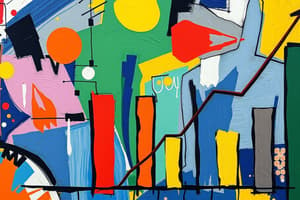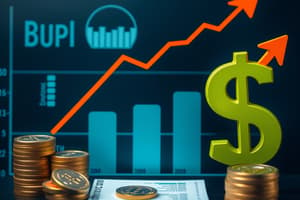Podcast
Questions and Answers
Which of the following best describes the production function?
Which of the following best describes the production function?
- The financial statement outlining a firm's revenue.
- A technical relationship between inputs and outputs. (correct)
- The process of transforming outputs into inputs
- The stages of short run production.
Which of the following inputs is most likely to be considered a fixed input for a brewery in the short run?
Which of the following inputs is most likely to be considered a fixed input for a brewery in the short run?
- Electricity
- Additional machinery
- Unskilled labor (correct)
- Raw materials (e.g., hops, barley)
In economics, what characterizes the 'short run'?
In economics, what characterizes the 'short run'?
- A period less than one month.
- A period in which all inputs can be varied.
- A period less than one year. (correct)
- A period in which at least one input is fixed.
In the context of production, what does 'Total Product (TP)' represent?
In the context of production, what does 'Total Product (TP)' represent?
If the marginal product of labor (MPL) is greater than the average product of labor (APL), what must be true of APL?
If the marginal product of labor (MPL) is greater than the average product of labor (APL), what must be true of APL?
What is the defining characteristic of Stage I of short-run production?
What is the defining characteristic of Stage I of short-run production?
At what point does the Law of Diminishing Returns begin to take effect?
At what point does the Law of Diminishing Returns begin to take effect?
In Stage II of short-run production, what condition applies to the marginal product (MP) of the variable input?
In Stage II of short-run production, what condition applies to the marginal product (MP) of the variable input?
Why is Stage III considered an irrational stage of production?
Why is Stage III considered an irrational stage of production?
What is the primary difference between 'economic cost' and 'accounting cost'?
What is the primary difference between 'economic cost' and 'accounting cost'?
What are 'explicit costs'?
What are 'explicit costs'?
If a business owner uses their own capital in their business, what type of cost does this represent?
If a business owner uses their own capital in their business, what type of cost does this represent?
Which statement accurately describes the relationship between accounting profit and economic profit?
Which statement accurately describes the relationship between accounting profit and economic profit?
What does a firm's cost function represent?
What does a firm's cost function represent?
What are the two components of Total Cost (TC) in the short run?
What are the two components of Total Cost (TC) in the short run?
Total Fixed Cost (TFC) is represented graphically by which type of line?
Total Fixed Cost (TFC) is represented graphically by which type of line?
If a firm produces zero output, what happens to Total Variable Cost (TVC)?
If a firm produces zero output, what happens to Total Variable Cost (TVC)?
Why does the Total Variable Cost (TVC) curve typically have an inverse S-shape?
Why does the Total Variable Cost (TVC) curve typically have an inverse S-shape?
Which of the following is the correct formula for calculating Average Fixed Cost (AFC)?
Which of the following is the correct formula for calculating Average Fixed Cost (AFC)?
Which of the following statements describes the shape of the Average Variable Cost (AVC) curve in the short run?
Which of the following statements describes the shape of the Average Variable Cost (AVC) curve in the short run?
Marginal Cost (MC) is best defined as:
Marginal Cost (MC) is best defined as:
Where does the Marginal Cost (MC) curve intersect the Average Total Cost (ATC) and Average Variable Cost (AVC) curves?
Where does the Marginal Cost (MC) curve intersect the Average Total Cost (ATC) and Average Variable Cost (AVC) curves?
When the Marginal Product of Labor (MPL) is increasing, what is happening to Marginal Cost (MC)?
When the Marginal Product of Labor (MPL) is increasing, what is happening to Marginal Cost (MC)?
When Average Product of Labor (APL) is at its maximum, which of the following must be true?
When Average Product of Labor (APL) is at its maximum, which of the following must be true?
What factor characterizes a 'pure competition' market?
What factor characterizes a 'pure competition' market?
In a perfectly competitive market, what does it mean for a firm to be a 'price taker'?
In a perfectly competitive market, what does it mean for a firm to be a 'price taker'?
What condition is satisfied by the demand curve (Df) faced by an individual firm in perfect competition?
What condition is satisfied by the demand curve (Df) faced by an individual firm in perfect competition?
What is the primary goal of a firm, in terms of total revenue (TR) and total cost (TC)?
What is the primary goal of a firm, in terms of total revenue (TR) and total cost (TC)?
In the marginal approach to profit maximization, at what quantity of output does profit typically reach the maximum amount?
In the marginal approach to profit maximization, at what quantity of output does profit typically reach the maximum amount?
If a firm is operating at an output level where Marginal Cost (MC) equals Marginal Revenue (MR) but MC is decreasing, what situation is the firm in?
If a firm is operating at an output level where Marginal Cost (MC) equals Marginal Revenue (MR) but MC is decreasing, what situation is the firm in?
If a firm's Average Total Cost (ATC) is below the market price at equilibrium in a perfectly competitive market, what will occur?
If a firm's Average Total Cost (ATC) is below the market price at equilibrium in a perfectly competitive market, what will occur?
Under what condition will a firm continue to produce in the short run even if Average Total Cost (ATC) exceeds price?
Under what condition will a firm continue to produce in the short run even if Average Total Cost (ATC) exceeds price?
When does a firm reach to a 'shutdown point'?
When does a firm reach to a 'shutdown point'?
A market condition where a single company is the sole source for a product, and entry of other firms is completely blocked, is known as:
A market condition where a single company is the sole source for a product, and entry of other firms is completely blocked, is known as:
Which characteristics applies to a pure monopoly?
Which characteristics applies to a pure monopoly?
Which factor can protect a monopoly company from having competition in the industry?
Which factor can protect a monopoly company from having competition in the industry?
What is a main difference between a firm in monopolistic competition and one in perfect competition?
What is a main difference between a firm in monopolistic competition and one in perfect competition?
What is the key characteristic of an oligopoly?
What is the key characteristic of an oligopoly?
Which type of market is most likely to involve firms engaging in non-price competition?
Which type of market is most likely to involve firms engaging in non-price competition?
Flashcards
What is production?
What is production?
Act of transforming inputs into outputs, creating value or utility through tangible goods/intangible services.
What is a production function?
What is a production function?
Technical relationship showing maximum output from a set of inputs with given technology, expressed as equation/table/graph.
What are fixed inputs?
What are fixed inputs?
Inputs whose quantity is difficult to change quickly in response to market conditions.
What are variable inputs?
What are variable inputs?
Signup and view all the flashcards
What is the short run?
What is the short run?
Signup and view all the flashcards
What is Total Product (TP)?
What is Total Product (TP)?
Signup and view all the flashcards
What is Marginal Product (MP)?
What is Marginal Product (MP)?
Signup and view all the flashcards
What is Average Product (AP)?
What is Average Product (AP)?
Signup and view all the flashcards
What is the law of variable proportions?
What is the law of variable proportions?
Signup and view all the flashcards
What is Stage I of production?
What is Stage I of production?
Signup and view all the flashcards
What is Stage II of production?
What is Stage II of production?
Signup and view all the flashcards
What is Stage III of production?
What is Stage III of production?
Signup and view all the flashcards
What is cost?
What is cost?
Signup and view all the flashcards
What are explicit costs?
What are explicit costs?
Signup and view all the flashcards
What are implicit costs?
What are implicit costs?
Signup and view all the flashcards
What is accounting profit?
What is accounting profit?
Signup and view all the flashcards
What is economic profit?
What is economic profit?
Signup and view all the flashcards
What is a cost function?
What is a cost function?
Signup and view all the flashcards
What are Total Fixed Costs (TFC)?
What are Total Fixed Costs (TFC)?
Signup and view all the flashcards
What are Total Variable Costs (TVC)?
What are Total Variable Costs (TVC)?
Signup and view all the flashcards
What is Total Cost (TC)?
What is Total Cost (TC)?
Signup and view all the flashcards
Average Fixed Cost (AFC)?
Average Fixed Cost (AFC)?
Signup and view all the flashcards
What is Average Variable Cost (AVC)?
What is Average Variable Cost (AVC)?
Signup and view all the flashcards
What is Average Total Cost (ATC)?
What is Average Total Cost (ATC)?
Signup and view all the flashcards
What is Marginal Cost (MC)?
What is Marginal Cost (MC)?
Signup and view all the flashcards
What is perfect competition?
What is perfect competition?
Signup and view all the flashcards
What is Total Revenue (TR)?
What is Total Revenue (TR)?
Signup and view all the flashcards
What is Average Revenue (AR)?
What is Average Revenue (AR)?
Signup and view all the flashcards
What is Marginal Revenue (MR)?
What is Marginal Revenue (MR)?
Signup and view all the flashcards
How does a firm maximize profit?
How does a firm maximize profit?
Signup and view all the flashcards
What is a monopoly market?
What is a monopoly market?
Signup and view all the flashcards
Monopolistically competitive market?
Monopolistically competitive market?
Signup and view all the flashcards
What is oligopoly market?
What is oligopoly market?
Signup and view all the flashcards
What is National Income Accounting (NIA)?
What is National Income Accounting (NIA)?
Signup and view all the flashcards
What is Gross Domestic Product (GDP?
What is Gross Domestic Product (GDP?
Signup and view all the flashcards
What is Gross National Product (GNP)?
What is Gross National Product (GNP)?
Signup and view all the flashcards
What is business cycle?
What is business cycle?
Signup and view all the flashcards
What is Inflation?
What is Inflation?
Signup and view all the flashcards
What is monetary policy?
What is monetary policy?
Signup and view all the flashcards
What is Fiscal policy?
What is Fiscal policy?
Signup and view all the flashcards
Study Notes
Theory of Production and Cost
- This chapter covers basic production concepts, cost analysis, short-run production, and cost functions
- The topics include: production function, input types, economic and accounting cost, cost functions, and their relationships
Chapter Objectives
- Define production and production function
- Differentiate between fixed and variable inputs
- Describe short-run total, average, and marginal product
- Compare the three stages of production in the short run
- Explain the differences between accounting cost and economic cost
- Describe total cost, average cost, and marginal cost functions
- Explain the relationship between short run production functions and short run cost functions
Theory Of Production In The Short Run
- Raw materials must be transformed into outputs to provide better utility
- The process of converting inputs (land, labor, capital, entrepreneurial ability) into outputs
Definition of Production
- Turns inputs into outputs
- Production creates worth or benefit
- Tangible (goods) or intangible (services) result
Production Function
- The maximum output that can be produced with a given amount of inputs and technology
- Can be an algebraic equation, table, or graph
Inputs
- Q = f(X1, X2, X3,..., Xn), where Q is output and X1, X2, X3, ..., Xn are different types of inputs
- Classification of inputs: fixed and variable
Fixed Inputs
- The quantity cannot be easily changed when market conditions necessitate immediate output adjustment
- While not absolutely fixed, they remain constant during an immediate requirement
- Examples include buildings, land, and machinery because their quantity can't be easily changed in the short term
Variable Inputs
- Quantities can be changed rapidly to match desired output changes
- The quantity can be easily reduced if market demand decreases and vice versa
- Unskilled labor is a classic example
Short Run
- Economic context: a period when at least one input remains fixed
- It is a period insufficient to alter all inputs simultaneously
- Short run durations vary across firms
- The analysis focuses on production with one variable and one fixed input
Production Function (Capital and Labor)
- Q = f(L), where Q is output and L is the quantity of labor
- Output increases by increasing the amount of labor used
- Illustrates the possible outputs from using different amounts of labor with fixed capital
- Output changes are only achievable when the amount of labor changes because capital is fixed
Total, Average, and Marginal Product
- Variables that describe the impact of a variable input on production
Total Product (TP)
- The maximum amount of output from specific combinations of variable and fixed inputs
- Increasing variable input increases total product up to a point
- Combining more variable input with fixed input raises total product
- Employing too much variable input with fixed input leads to output decline
- TP function trend in the short-run:
- Increases at an increasing rate
- Increases at a decreasing rate
- Reaches a maximum point
- Falls as the quantity of the variable input rises
Marginal Product (MP)
- It is the change in output from one more unit of variable input while other inputs are constant
- Marginal Product of Labour (MPL) applies to the addition of one worker
- MP₁ measures the slope of the total product curve at a given point
- MP = dTP/dL = ΔQ/ΔL
- Marginal product of the variable input trend in the short run:
- First increases
- Reaches its maximum
- Decreases to a negative value as more variable input combines with fixed input
Average Product (AP)
- The level of output each unit of input produces on average
- It is the mean contribution of each variable input to total output
- Mathematically, the ratio of total output to variable input number
- The average product of labor (APL) is given by APL = TP/L
- Average product of labor increases, reaches maximum, and then declines
Graphs
- The AP curve can be measured by the inclination of rays extending from the origin to a point on the TP curve
- APL at L2 is the ratio of TP2 to L2 and is the inclination of ray a
- When APL is increasing, MPL > APL
- When APL is at its maximum, MPL = APL
- When APL is decreasing, MPL < APL
Example Cut-Flower Firm
- Given: Q= 4KL- 0.6K2 - 0.1L2, where Q is cut-flower quantity, L is labor, K is fixed capital (K=5)
- Need to determine:
- Average product of labor (APL) function
- Level of labor which maximizes cut-flower output
- Maximum achievable amount of cut-flower production
Law of Variable Proportions
- Adding successive units of a variable input to a fixed input will, beyond some point, decrease the marginal product attributed to each additional unit of the variable resource
- Hiring more workers with constant capital eventually leads to smaller output increases
Assumptions of the Law of Variable Proportions
- Assumes fixed technology
- Assumes that the techniques of production do not change
- All labor units are of equal quality (innate ability, education, training, experience) Marginal product diminishes because more workers are used relative to available plant and equipment
- The law starts to operate when the number of workers exceeds L1 in Figure 4.1, after the marginal product curve reaches its maximum and is also called the law of diminishing returns
Stages Of Production
- Determining the variable input (labor) for a firm depends on factors beyond labor productivity
- Economists define three short-run production stages
Stage I
- The average product (APL) increases to a maximum
- Extends from the origin to the point where MPL = APL, up to L2 in figure 4.1
- The region is not efficient due to the variable input being too small and the fixed input being underutilized
Stage II
- Ranges from APL at its maximum (MPL=APL) to MPL at zero (L2 to L3 in figure 4.1)
- Output still increases with more labor but at a decreasing rate
- Also known as diminishing marginal returns
- Scarcity of the fixed factor is the reason for decreasing average and marginal products
- The efficient region of production is where the marginal product of the variable input is positive
Stage III
- Increasing variable input decreases total product
- Total product curve slopes downwards
- Also known as negative marginal returns because the variable input's marginal product becomes negative
- Excessive variable input relative to fixed input is the cause and fixed input is over-utilized
- The increase in variable inputs is contributing negatively to total product
- Stage III exists when labor beyond L3 because additional labor is counterproductive
Theory Of Costs In The Short Run
- Definition and types of costs
Definition of Cost
- Cost is the monetary value of inputs to produce a product
- Acquiring inputs requires purchase from resource suppliers
Economic vs Accounting Profit
- Accountants: Profit = Total Revenue - Explicit Costs
- Economists: Economic Profit = Total Revenue - Economic Costs (Explicit Costs + Implicit Costs)
Accounting Cost
- Ignores the value of non-purchased (self-owned) inputs
- Does not include direct expenses, wages/salaries, cost of raw materials, interest on borrowed funds, depreciation allowances and utility expenses
Explicit Costs
- Out-of-pocket expenses for purchased inputs
- Profit calculated with only explicit costs is accounting profit
Economic Cost
- Includes the monetary value of all inputs (purchased and non-purchased)
- Calculating economic costs involves estimating the opportunity costs of non-purchased inputs
- The estimated monetary cost for non-purchased inputs is known as implicit cost
Implicit Cost
- Ex: Mr. X quits a job paying Birr 10,000/month to run a firm
- Salary forgone is the opportunity cost of his labor at Birr 10,000/month
- Economic cost = implicit cost + explicit cost
Economic Profit
- Economic profit will give the real profit
- Accounting profit is greater than economic profit by the implicit cost amount
Short Run Cost
- A cost function represents the total cost (C) required for producing a certain quantity (Q) of output by the equation C = f(Q)
Total Cost (TC)
- Short run can be divided into:
- Total Fixed Cost (TFC)
- Total Variable Cost (TVC)
Fixed Costs
- Do not change with the level of output
- Unavoidable unless the firm shuts down
- Include: administrative staff salaries, building depreciation, land maintenance, and rent
Variable Costs
- Change directly with the level of output
- Zero if output is zero
- Include: raw materials, direct labor, and expenses for fuel, water, and electricity
Calculating Total Cost
- In short run, TC = TFC + TVC
Total Fixed Cost(Shape)
- TFC is a straight, horizontal line parallel to the output (x) axis
- Because it does not vary with output level
Total Variable Cost
- TVC has an inverse S-shape, illustrating the law of variable proportions
- TVC increases at a decreasing rate because productivity increases with more variable factor employed
- After optimal combination, variable factor productivity declines, and TVC increases at an increasing rate
Total Cost (Shape)
- TC curve is derived by vertically summing TFC and TVC at each output level
- Has an inverse S-shape like TVC
- When output is zero, TVC is also zero; thus, TC = TFC
Per Unit Costs
- Can be derived from total cost functions and are important for short-run firm analysis
Average Fixed Cost (AFC)
- Total fixed cost per unit of production
- AFC = TFC/Q
- The AFC curve declines continuously and approaches both axes asymptotically
Average Variable Cost (AVC)
- Total variable cost per unit of output
- Calculated by dividing TVC by the level of output: AVC = TVC/Q
- The short-run AVC initially decreases, reaches a minimum, and then increases, making its curve U-shaped due to the law of variable proportions
Average Total Cost (ATC)
- It is also known as Average Cost(AC) is the total cost per unit of output
- Calculated by dividing total cost by the level of output: AC = TC/Q
- Expressed as AC = (TVC + TFC)/Q = AVC + AFC
- Thus, AC can also be obtained by adding AVC and AFC vertically
Marginal Cost (MC)
- It is the extra cost a firm pays to produce a one more unit of output
- MC is the change in total cost from a small change in output level, or MC = dTC/dQ
- MC is also the change in TVC with respect to a unit change in the level of output
- MC = (dTFC + dTVC)/dQ = dTVC/dQ, since dTFC/dQ = 0 Given the inverse S-shaped TC and TVC, MC decreases initially, reaches its minimum, and then increases
MC Curves
- AVC, AC, and MC curves are all U-shaped due to the law of variable proportions
- In the provided figure, the AVC curve is at its minimum at Q1, while the AC curve reaches its minimum at Q2
- AFC (the vertical difference between AC and AVC) continuously decreases as output increases
- Notably, the MC curve intersects both the AVC and AC curves at their minimum points
The relationship between short run production and cost curves
These conditions suggest that the connection among MC and MPL as well as the relationship between AVC and AMPL can be derived if the business uses labour as a variable input in the short term and takes capital as a set input when the cost of labour is w, which is constant
Marginal Cost And Marginal Product of Labour
- MC TVC / Q, where TVC w.. The expression shows that mc and MPL are negatively associated
- Mc decreases when MPL increases and vice versa
Average Variable Cost and Average Product of Labour
- AVC TVC / Q,, where, TVC w.L
Studying That Suits You
Use AI to generate personalized quizzes and flashcards to suit your learning preferences.
Related Documents
Description
Basic production concepts, cost analysis, and cost functions are covered. Topics include production function, types of inputs, economic and accounting cost, as well as their relationships. It also describes total cost, average cost, and marginal cost functions.




